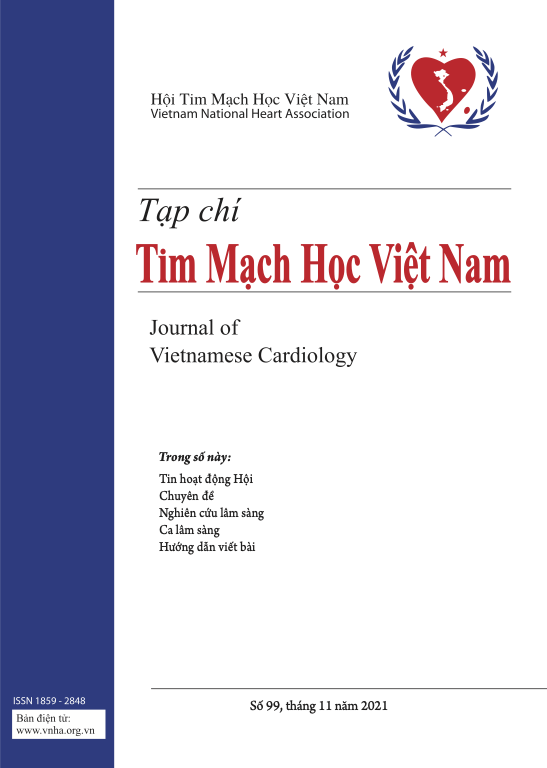GHÉP TIM: CHỈ ĐỊNH, ĐIỀU TRỊ VÀ KẾT QUẢ
DOI:
https://doi.org/10.58354/jvc.104.2023.298Tóm tắt
Mặc dù có những tiến bộ lớn trong điều trị suy tim, tiên lượng và các biện pháp nhằm kéo dài thời gian sống của bệnh nhân suy tim nặng tiến triển vẫn còn là một vấn đề nan giải. Ghép tim là một lựa chọn rất tốt cho bệnh nhân suy tim giai đoạn cuối nhằm kéo dài sự sống với chất lượng cuộc sống tốt hơn mà không có biện pháp điều trị nào khác làm được. Những tiến bộ gần đây trong điều trị thuốc ức chế miễn dịch, thủ tục hiến tạng, kỹ thuật phẫu thuật và chăm sóc bệnh nhân sau ghép đã làm giảm đáng kể tỷ lệ tử vong, nâng cao chất lượng cuộc sống và thời gian sống sau ghép cho người bệnh ghép tim. Tuy nhiên, để duy trì cuộc sống lâu dài của bệnh nhân sau ghép cần kiểm soát và quản lý tốt các vấn đề về thải ghép, nhiễm trùng, bệnh mạch vành sau ghép và bệnh lý ác tính. Đảm bảo tính cân bằng giữa lợi ích và nguy cơ trong sử dụng các thuốc ức chế miễn dịch và theo dõi sát các biến chứng để cải thiện kết quả lâu dài của người nhận tim.
Tài liệu tham khảo
Barnard C.N. (1967). The operation. A human cardiac transplant: an interim report of a successful operation performed at Groote Schuur Hospital, Cape Town. S Afr Med J. 41 (48), 1271-4.
![]()
Reitz B.A., et al. (1981). Orthotopic heart and combined heart and lung transplantation with cyclosporin-A immune suppression. Transplant Proc. 13 (1 Pt 1), 393-6.
![]()
Khush K.K., et al. (2019). The International Thoracic Organ Transplant Registry of the International Society for Heart and Lung Transplantation: Thirty-sixth adult heart transplantation report - 2019; focus theme: Donor and recipient size match. J Heart Lung Transplant. 38 (10), 1056-1066.
![]()
Krittayaphong R., Ariyachaipanich A. (2015). Heart Transplant in Asia. Heart Fail Clin. 11 (4), 563-72.
![]()
Lê Trung Hải (2013). Cập nhật một số kết quả ghép tạng. Gan mật Việt Nam. 24, 62-65.
![]()
Nguyễn Hữu Ước, et al. (2012). Kết quả 4 ca ghép tim đầu tiên từ người cho đa tạng chết não tại Bệnh viện Hữu nghị Việt Đức. Ngoại khoa. 4, 3-10.
![]()
Mehra M.R., et al. (2016). The 2016 International Society for Heart Lung Transplantation listing criteria for heart transplantation: A 10-year update. J Heart Lung Transplant. 35 (1), 1-23.
![]()
Morcos A. Awad, Aakash Shah, Bartley P. Griffith. Current status and outcomes in heart transplantation: a narrative review. Rev. Cardiovasc. Med. 2022, 23(1), 11.
![]()
Mehra M.R., et al. (2006). Listing criteria for heart transplantation: International Society for Heart and Lung Transplantation guidelines for the care of cardiac transplant candidates--2006. J Heart Lung Transplant. 25 (9), 1024-42.
![]()
Awad M., et al. (2016). Early Denervation and Later Reinnervation of the Heart Following Cardiac Transplantation: A Review. J Am Heart Assoc. 5 (11).
![]()
Kobashigawa J. (2017). Clinical Guide to Heart Transplantation, Springer, Los Angeles (CA).
![]()
Russo M.J., et al. (2010). Factors associated with primary graft failure after heart transplantation. Transplantation. 90 (4), 444-50.
![]()
Kittleson MM, Patel JK, Kobashigawa JA. (2017). Chapter 72: cardiac transplantation. Hurst's the Heart. . H.R. Fuster V, Narula J, Eapen ZJ, , Editor, McGraw-Hill; 2017., New York (NY).
![]()
Pham M.X., et al. (2010). Gene-expression profiling for rejection surveillance after cardiac transplantation. N Engl J Med. 362 (20), 1890-900.
![]()
Kobashigawa J.A., et al. (2005). Multicenter intravascular ultrasound validation study among heart transplant recipients: outcomes after five years. J Am Coll Cardiol. 45 (9), 1532-7.
![]()
Dantal J., Soulillou J.P. (2005). Immunosuppressive drugs and the risk of cancer after organ transplantation. N Engl J Med. 352 (13), 1371-3.
![]()
Wilhelm M.J. (2015). Long-term outcome following heart transplantation: current perspective. J Thorac Dis. 7 (3), 549-51.
![]()








